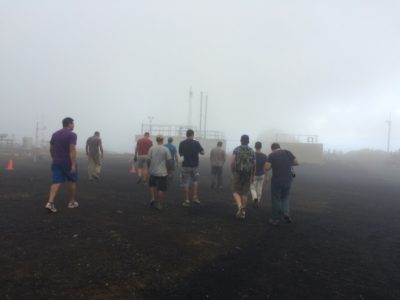AGU Scoop: A Behind-the-Scenes Look at Working With ARM
Published: 1 December 2020

The opening day of the 2020 American Geophysical Union (AGU) Fall Meeting featured a virtual town hall on collaborating with ARM and other U.S. Department of Energy (DOE) scientific user facilities.
Paquita Zuidema shared her wisdom gleaned while leading ARM’s Layered Atlantic Smoke Interactions with Clouds (LASIC) field campaign. ARM deployed one of its three mobile facilities to Ascension Island for the LASIC campaign from June 2016 through October 2017.
“The DOE ARM program has had a long history of deployments to isolated places around the world that were very scientifically interesting and meaningful,” said Zuidema, showing a world map that pinpointed locations of ARM field campaigns.
From June to October each year, smoke floating westward from African agricultural fires tends to blanket low-lying clouds over the South Atlantic Ocean. Researchers are unsure how much smoke interacts with or sinks beneath the clouds. LASIC’s aim of untangling the processes involved could have big implications for earth system models, which show different levels of warming or cooling over the region.
“The suite of instruments that are included in these ARM Mobile Facilities are really perfect for addressing the question of how clouds and aerosols interact with each other,” said Zuidema.
She also praised the technicians who monitored ARM instruments onsite and helped keep measurements coming in 24 hours a day, seven days a week during the 17-month LASIC deployment.

“You’re getting these continuous measurements that can really help you puzzle out the aerosol effects separately from the meteorology,” said Zuidema, a professor in the University of Miami’s Rosenstiel School of Marine and Atmospheric Science.
Zuidema encouraged scientists in the Zoom audience to propose an ARM field campaign, noting the support that ARM provides to its users.
“It really lets you focus on your science while the data quality control and release are taken care of by people who are experts at doing it,” she said.
To prepare a successful proposal, Zuidema, a member of the ARM User Executive Committee, recommended thinking about how ARM observations can help you answer your science questions. Reviewing Atmospheric System Research (ASR) science goals and ARM Mobile Facility white papers and attending ARM/ASR meetings are good entry points.
Zuidema also suggested reaching out to experts within ARM as well as researchers beyond the ARM/ASR space. Outside researchers, said Zuidema, “can bring something fresh to ARM/ASR science and make the project more meaningful for the scientific community.”
“If you have a large-scale problem, a DOE user facility is the place to go.”
Sharlene Weatherwax, Associate Director of Science for DOE’s Biological and Environmental Research program
Sharlene Weatherwax, Associate Director of Science for the DOE Biological and Environmental Research program, opened the town hall with an introduction of DOE Office of Science user facilities. Such user facilities include ARM, the Joint Genome Institute (JGI) at Lawrence Berkeley National Laboratory in California, and the Environmental Molecular Sciences Laboratory (EMSL) at Pacific Northwest National Laboratory in Washington state.
“A user facility generally provides something that is not available at the scale of an individual institution or a routine private-sector capability,” said Weatherwax of the expertise, instrumentation, and data management available at an entity such as ARM. “If you have a large-scale problem, a DOE user facility is the place to go.”
In addition to Zuidema, researchers familiar with JGI and EMSL discussed their user facility experiences during the hourlong town hall.
If you missed the town hall, you can still watch the recording if you are attending the AGU Fall Meeting.
–Contributions from ARM science writers Katie Dorsey and Corydon Ireland
Planning your AGU schedule? Get more information about ARM-focused AGU presentations.
Keep up with the Atmospheric Observer
Updates on ARM news, events, and opportunities delivered to your inbox
ARM User Profile
ARM welcomes users from all institutions and nations. A free ARM user account is needed to access ARM data.


















